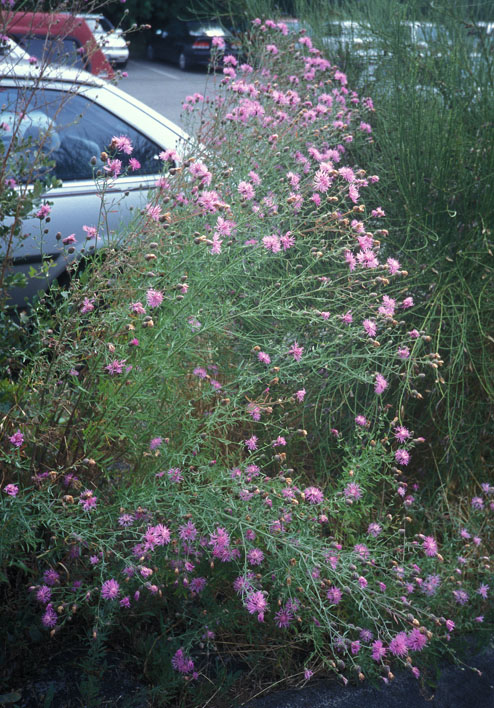
|
| Knapweed; Centaurea spp. |
Sunflower Family; COMPOSITÆ (ASTERACEÆ)
|
| When people complain about weeds, usually it's because they've a lawn or flowerbed tainted with dandelions or some such thing.
Or, underneath the rhodies three weed species are thriving. Well, big deal. Most weed problems faced by everyday gardeners are, in
the big picture, only petty grievances --like worrying about a lost button on one's shirt. So what if daisies grow on the lawn? |
| Knapweeds, on the other hand, are altering the ecology in a big way from central Washington into Montana. Their
success spells major trouble for rangers and native plant populations. Knapweeds would've been featured in this column before, except
they're only a minor presence in Seattle. |
| About 600 species of Centaurea are known, all native in the Old World. At least 14 species are wild in Washington. In
a genus so large it stands to reason that great variation prevails. For the most part, knapweeds are chaffy, hairy, sometimes spiny,
and unpalatable to livestock. Some species are lovely garden ornamentals, others fearsome, prickly tumbleweeds. They are related
to thistles, and all need sun, tolerate drought, and grow even on poor soil. They are not garden weeds. In Seattle, they favor
railroads, piers, industrial fringes, and sunny fields with disturbed soil. |
| Washington State University biologists have carefully studied these weeds, and written some great knapweed
brochures, with details about history, the extent of the problem, identification, and methods of attack. To curb the problem using
"ecologically correct" means, host-specific predators are released: gallflies, root-eating beetles, moths, weevils, and mites. The motto would seem
to be "If humans can't beat 'em, let bugs eat 'em." |
| Two major knapweeds, both in Seattle, are as follows. (December is a lousy time to go hunting them, but this newsletter
is monthly, and we have run out of "winter weeds" so have no choice.) |
| C. diffusa is usually a biennial, of tumbleweed nature; grows 8 to 40 inches tall; the flowers are white or pink-purplish,
3/4" wide. |
| C. maculosa (or properly C.
Biebersteinii) is a perennial, not a tumbleweed; grows 8 to 57 inches tall; the flowers pink
to purple, 1 to 2 inches wide. A lovely demon [PHOTOGRAPHED ABOVE]. |
Both bloom from late June into early October, are from southern Europe, and have infested the Pacific Northwest since the
1890s. Garden species of Centaurea include Bachelor's Button (C. Cyanus), Lemon Fluff (C. macrocephala), Mountain Bluet (C. montana), and Sweet Sultan (C. moschata).
|
Originally published as the Seattle Tilth newsletter Weed of the Month in December 1994, along with an illustration from a book.
Back |
|
|

